Withlacoochee River System Update - 4/3/2023
Southwest Florida Water Management District sent this bulletin at 04/03/2023 07:54 PM EDTWithlacoochee Levels Drop as Dry Conditions Persist
Rainfall:
- To say it’s been dry would be an understatement.
- Our region has not seen appreciable rainfall for some time now.
- Both surface (lake/river) and groundwater (aquifer) levels have been steadily dropping over the past 4 months.
- So far this year (January through March) our region has received just over 3 inches of rainfall…
- …which is only a third of the historical average rainfall (9.5 inches) for the first three months of the year.
- Last month, we received less than an inch, much lower than the March historical average (3.8 inches).
- Region-wide aquifer (groundwater) levels have continued to drop and are currently in the 39th percentile, well below average, and much lower than they were a year ago (84th percentile).
- The 50th percentile is average (half the time levels have been higher and half the time they’ve been lower). So, the 39th percentile means recorded aquifer levels have only been lower this time of year 39 percent of the time.
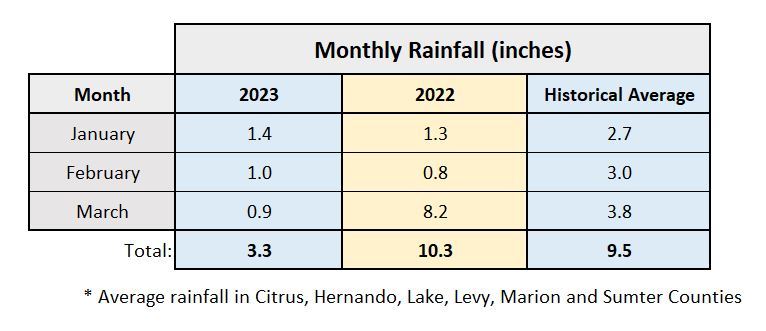
A Gator Claims one of the Remaining Water Holes left in the Green Swamp (March 2023)
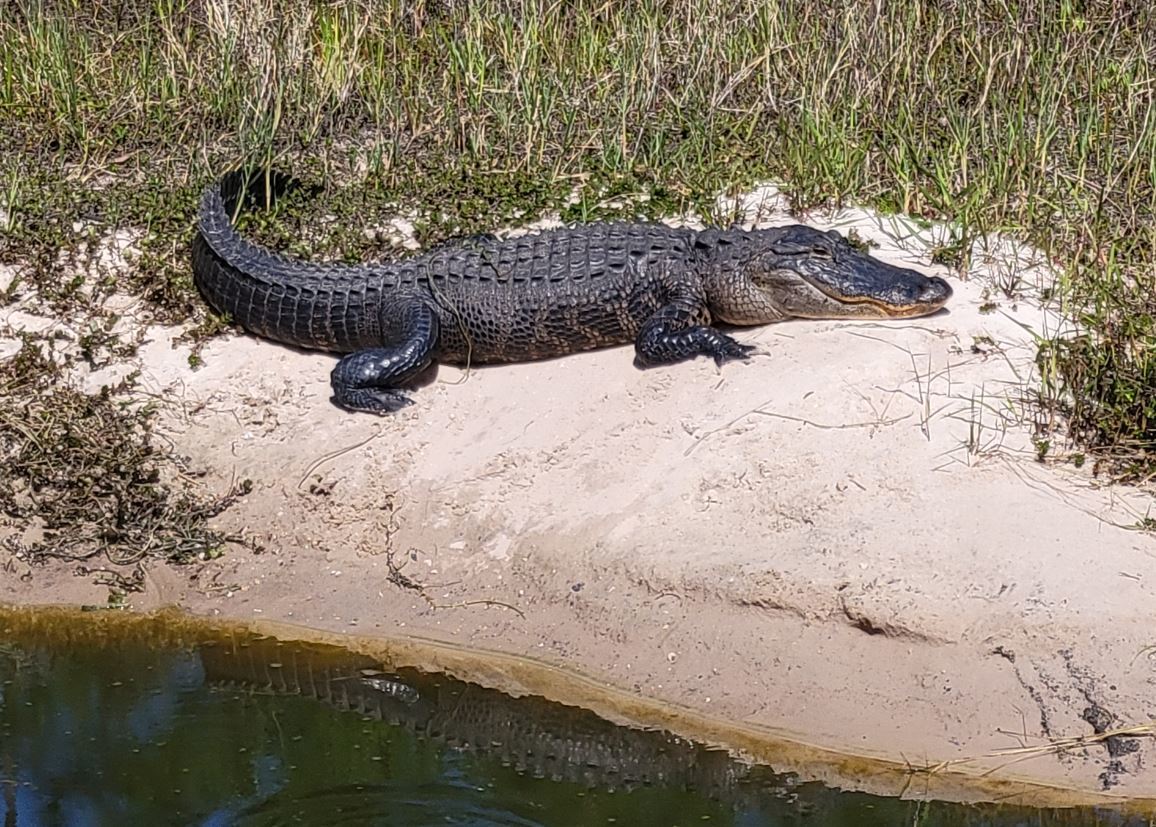
Withlacoochee River (from the Green Swamp downstream past Hwy 200):
- It’s normal for river levels and flows to slowly decline this time of year.
- Sometimes, spring rainfall will cause a substantial rebound, but that hasn’t been the case so far this year.
- Water levels and flows along the Withlacoochee River have steadily dropped since late November.
- In areas with high riverbanks and a narrow channel (like Trilby and Ridge Manor) the Withlacoochee has fallen 7 to 8 feet in the past 4 months.
- In other areas where the river is wider, and flows can spread out (like Nobleton and Hwy44) the river has dropped 2 to 3 feet since late November.
- In the Green Swamp, where the river begins, flows have all but ceased as many of the wetlands are now dry.
- Just last month, the Withlacoochee River dropped another foot.
- River levels and flows are now several feet lower than they were this time last year, and we can expect further declines unless our area receives significant rainfall soon.

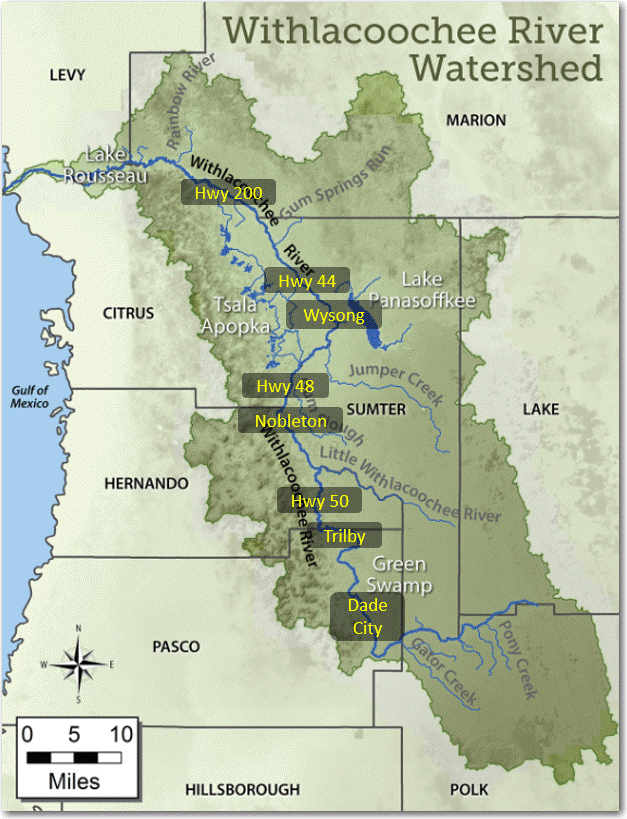
The Withlacoochee River Meanders through the State Forest near Lacoochee (March 2023)
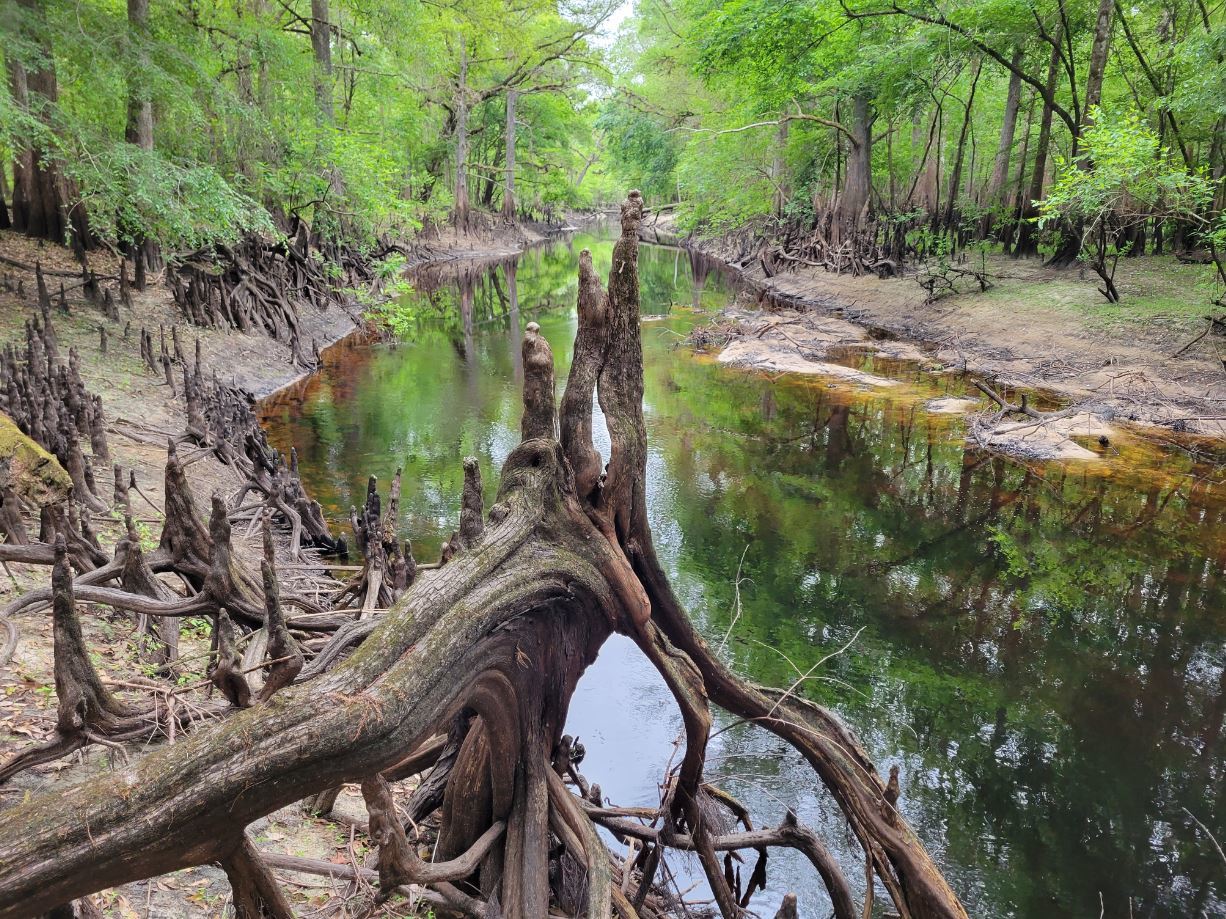
Tsala Apopka Chain of Lakes:
- Water levels throughout the Tsala Apopka Chain of Lakes are still dropping as our dry season continues.
- Since mid-November, lake/canal levels have fallen 1.5 feet, including a 7 inch drop last month.
- Water levels are naturally declining from evaporation and downward leakage to the underlying aquifer (which is below the lake level).
- Historically, the lakes drop the quickest in April and May, so unless we see substantial rainfall, lake levels could be very low by summer.
- All three pools within the lake chain are about 16 inches lower than they were a year ago.
- The Withlacoochee River remains lower than the lakes, and river inflows won’t likely occur again until sometime this summer.
- The water control structures, aka “locks”, which were closed in early November, remain closed helping to conserve water in the lake chain.
- Work continues on the S-353 structure within the Hernando Pool. Voids that were discovered under the concrete spillway have been filled and concrete repairs will begin this week.

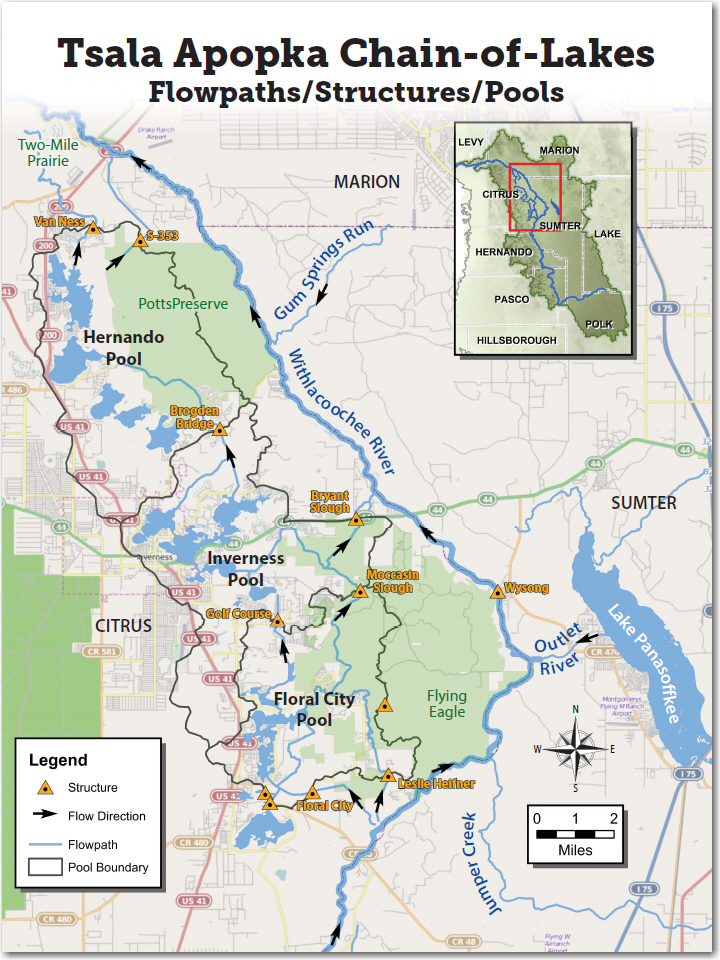
Contractors Work to Fill Voids under the Concrete Spillway at S-353 (March 2023)

Lake Panasoffkee and Wysong:
- Across the river in Sumter County is Lake Panasoffkee, which provides year-round flow to the Withlacoochee River.
- Water levels in Panasoffkee rise and fall throughout the year based on changing inflows and outflows that are governed by rainfall.
- When flows are low, the Wysong Structure on the Withlacoochee River can also influence Lake Panasoffkee.
- Incoming spring flows to Lake Panasoffkee have been dropping in recent weeks, due to less rain.
- Measured inflows from Little Jones Creek and Shady Brook fell by 30% in March.
- Outflow from Lake Panasoffkee to the Withlacoochee declined by 32% over the past month.
- Overall, the water level on Lake Panasoffkee dropped 2 inches in March.
- Currently, the 230-foot-wide main gate at Wysong is fully raised, while the 19-foot-wide independent gate is mostly raised.
- River flows at Wysong decreased by 75% in March.
- If river flows continue to drop, Wysong will have to be incrementally lowered to allow the river to flow downstream.
- This will cause water levels on Lake Panasoffkee to drop even quicker than they are now.
- The only way to prevent this is for our region to receive substantial rainfall in the coming weeks.

Current Look at the Wysong Structure on the Withlacoochee River (April 3, 2023)

Lake Rousseau and the Lower Withlacoochee River (from Dunnellon to the Gulf of Mexico):
- Downstream from Dunnellon, the Withlacoochee River is influenced by water control structures on Lake Rousseau.
- Inflow to Lake Rousseau includes combined flows from the Withlacoochee and Rainbow Rivers.
- Withlacoochee River flow (which depends on rainfall and runoff from adjacent lands) declined by 63% over the past month.
- Flow in the Rainbow River (which reflects changes in aquifer levels) is 3.4% lower than it was a month ago.
- Overall inflows to Lake Rousseau are about 15% lower than they were this time last year.
- The Rainbow River is currently contributing 75% of the total flow entering Lake Rousseau.

- In the late 1960s, the way water flowed out of Lake Rousseau was fundamentally changed.
- A bypass channel was constructed because the Cross Florida Barge Canal severed the final 9 miles of the Withlacoochee.
- Today, the primary outlet from Lake Rousseau is through the Inglis Bypass Spillway to the Lower Withlacoochee River (see maps below).
- The Inglis Main Dam, which discharges excess flows to the Barge Canal, was closed in early January and remains closed.
- All flow is still passing downstream through the Bypass Spillway, which is currently flowing at about 41% of its capacity.
- Over the next couple months, upstream flows are expected to continue to decline, causing less freshwater to pass downstream to the tidally influenced Lower Withlacoochee River.

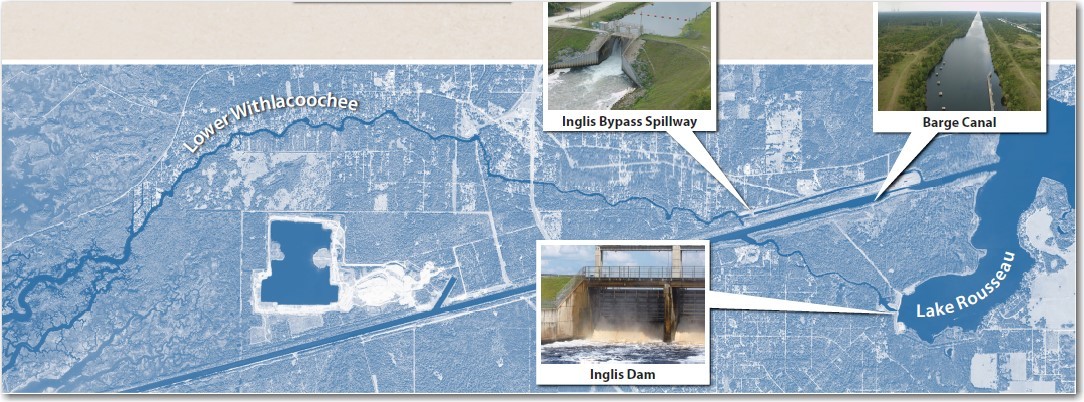
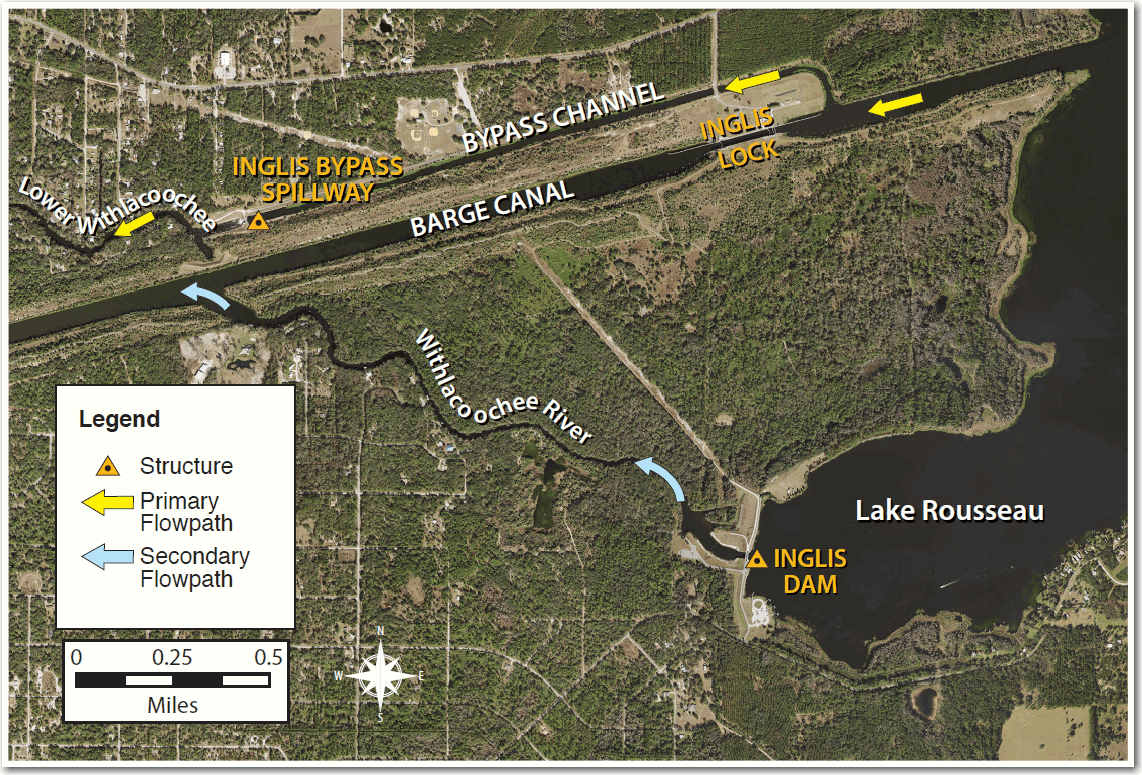
Hope you have a wonderful week!
Mark
Mark Fulkerson, Ph.D., P.E.
Chief Professional Engineer
Water Resources Bureau
Southwest Florida Water Management District
(352) 269-6073 (office)
(352) 279-4493 (cell)

